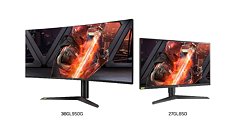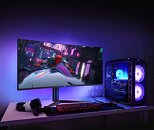Wednesday, June 12th 2019

LG Unveils the UltraGear Nano IPS NVIDIA G-SYNC Gaming Monitor - World's First 1ms IPS Display
At this year's E3, LG Electronics (LG) is unveiling the new LG UltraGear Nano IPS NVIDIA G-SYNC gaming monitor, the world's first 1 millisecond (ms)1 IPS display. The UltraGear is a gamer's dream come true, employing Nano IPS technology to achieve phenomenal color reproduction, ultra-fast response time and a refresh rate of 144 Hz, overclockable to 175 Hz. With blazing speed and stunning picture quality, LG's monitor is the complete package, enabling players to enjoy the most immersive gaming experience yet.
Available in 38- (model 38GL950G) and 27-inch (model 27GL850) screen sizes, both UltraGear Nano IPS monitors feature fast 144Hz refresh rate, high screen resolutions (38GL950G: 3840 x 1600, 27GL850: 2560 x 1440) and wide color gamut (DCI-P3 98 percent) for incredibly vibrant, flicker-free detailed images. The larger monitor is designed to increase gamers' sense of immersion with its 21:9 aspect ratio, curved screen, virtually borderless design and the upgraded Sphere Lighting 2.0, RGB lights on the back of the monitor that heighten the ambience when gaming by altering the colors of the lights to match the on-screen action.The 27-inch UltraGear is NVIDIA G-SYNC compatible and supports HDR10 while the larger 38-inch model supports both NVIDIA G-SYNC processor, VESA DisplayHDR 400 and is certified by NVIDIA through over 300 tests for performance and image quality to provide a great gaming experience. Both monitors deliver smooth motion without tearing or stuttering and include gamer-specific settings such as Dynamic Action Sync mode, Black Stabilizer and Crosshair for ultimate accuracy, especially in FPS games.
LG UltraGear Nano IPS gaming monitors are set to roll out next month, with pre-orders for model 27GL850 commencing in the United States on July 1 with availability in key European markets in the third quarter of this year.
Source:
LG NewsRoom
Available in 38- (model 38GL950G) and 27-inch (model 27GL850) screen sizes, both UltraGear Nano IPS monitors feature fast 144Hz refresh rate, high screen resolutions (38GL950G: 3840 x 1600, 27GL850: 2560 x 1440) and wide color gamut (DCI-P3 98 percent) for incredibly vibrant, flicker-free detailed images. The larger monitor is designed to increase gamers' sense of immersion with its 21:9 aspect ratio, curved screen, virtually borderless design and the upgraded Sphere Lighting 2.0, RGB lights on the back of the monitor that heighten the ambience when gaming by altering the colors of the lights to match the on-screen action.The 27-inch UltraGear is NVIDIA G-SYNC compatible and supports HDR10 while the larger 38-inch model supports both NVIDIA G-SYNC processor, VESA DisplayHDR 400 and is certified by NVIDIA through over 300 tests for performance and image quality to provide a great gaming experience. Both monitors deliver smooth motion without tearing or stuttering and include gamer-specific settings such as Dynamic Action Sync mode, Black Stabilizer and Crosshair for ultimate accuracy, especially in FPS games.
LG UltraGear Nano IPS gaming monitors are set to roll out next month, with pre-orders for model 27GL850 commencing in the United States on July 1 with availability in key European markets in the third quarter of this year.



29 Comments on LG Unveils the UltraGear Nano IPS NVIDIA G-SYNC Gaming Monitor - World's First 1ms IPS Display
LG 27GL850 is Adaptive Sync (FreeSync & G-Sync Comp)
the only other monitor that interests me is the new Asus one that can do both ULMB and gsync at the same time... but that one will probably cost double the price of this one, so eh. and I am not convinced 14 hour gaming sessions daily for months at a time that strobing backlight going super fast will wear out eventually... seems risky to me, so I will pass.
www.guru3d.com/news-story/new-vg27aqe-27asus-monitor-can-use-freesync-and-blur-reduction-simultaneously.html
Also I wonder how much are they lying with those bezels on 38GL950... :)
- only gave it two inputs, one DP and one HDMI. Seriously? For a premium product like this? That's just silly.
- stuck on a fugly, impractical, dumb external power brick. Again: seriously? Sure, external bricks are easily replaceable, but also tend to overheat and fail far more frequently than internal power supplies (I've never seen an internal monitor PSU fail), and are a complete pain to route and manage properly. Again: this does not belong on a premium product.
LG: Please get your act together. If you're making premium products, follow through.
There is absolutely no connection between the premium product grade and power supply placement.
I'd say that with the poor quality of components used in many self-proclaimed premium products, for example in "premium gaming displays", some of which have power supplies that have coil whine and the wine changes/intensifies depending on current refreshrate and APL of the scene, it is safer for everyone to have external power supply that can be moved away from the user, thus removing one of the potential weakpoints, among other advantages of this design, for example no need to send the entire freaking display for RMA in case of power supply fail.
Also if managing an external power brick is above your capabilities then maybe don't get this display and stick to newspapers.I was talking about glow, these are two entirely different things. Bleed is a backlight leakage that looks the same regardless of viewing distance, while glow is associated with viewing angles and intensifies at bigger angles, which with a display this wide is 100% of the time and you simply cannot make usable ultrawide without low glow panel, but despite that like 95% of them don't have low glow panels, including 34GK950. Basically only "pro" ultrawides have them, like LG 34UC98/99 (UW3 panel) or 38UC99 or 38WK95C (QW1 panel), all gaming display use either UW2 (original Acer X34, Asus PG348Q), UW4 (Acer X34P, Alienware AW3418DW) or UW5 (LG 34GK950G/F, presumably new Asus PG349Q as well), all of which have tons of glow, and inherent to the panel so all tales about "I don't have glow" can be put back to the certain three-letter place they were taken from.
b) Integrated monitor power supplies tend to be built-to-spec for that specific model (often largely (but not only) due to physical constraints), while external bricks tend to be off-the-shelf parts. This generally means better QC on the integrated parts, simply because the RMA process for an integrated PSU is more complicated and companies are generally less willing to risk the potential hassle of a failure-prone SKU. This has the added advantage of increasing PSU quality generally, meaning less chance for coil whine and other annoying issues - again, because it's built for the task. Then there's the fact that internal monitor PSUs have better cooling, as they can be ventilated, unlike 99% of power bricks which are sealed plastic casings with terrible thermal transfer. This, again, leads to longer lifespans and better operation (power output quality degrades as a PSU heats up). Of course sticking the PSU close to other heat-generating components can offset this somewhat, but even in my CFL-lit Dell U2711 - which gets hot - the PSU has lasted for 8+ years of intensive use with no complaints.
c) You're right that there isn't, but there ought to be a connection between premium grade products and type of PSU. Why? Because external bricks, being off-the-shelf, unoptimized parts, are inherently the cheap way out. In other words, any "premium" product with an external power brick is either cheaping out or making stupid decisions and prioritizing irrelevant factors (such as thinness) instead of product quality.
I generally think that devices like Samsung One Connect Box are the ultimate solution. You have just one cable for everything, so you put your monitor on an arm, connect the cable and thats the last time in years that you will have to go behind the display. The cable is sufficiently long so you can put this box anywhere it suits you (and there are very long ones available separately as well, in case you need more length). This way you can have everything - looks (so they can have their thin design), practicality (no need to reach behind the display and fight with cables anymore, also easy cable management since this is just one cable for everything) and no potential PSU related issues (PSU included in the device).
Other than that, I agree with you that external connectivity hubs are a very good idea - and ideally, the next A/V connectivity standard ought to be a universal interface like this, allowing for upgradeable boxes. It shouldn't need to be any more complicated that HDMI 2.1 or DP1.4 over a custom connector with a few extra power pins. The main issues would likely be latency (due to adding a new processing/switching step in between) as well as support for VRR and similar advanced technologies. Nothing that should be too big of an issue, though, and it would be incredibly practical.I'd be a bit surprised if this couldn't run in letterboxed 21:9 mode if needed.
I doubt it'll change much at all. Strobe is unpleasant at lower refresh rates, so effectively you'll still want your FPS/Hz high with a strobe.
Another day, another hype? ;)
This 27 inch LG looks very nice regardless. Curious about backlight bleed and glow levels. If they're solid... this might be a winner...